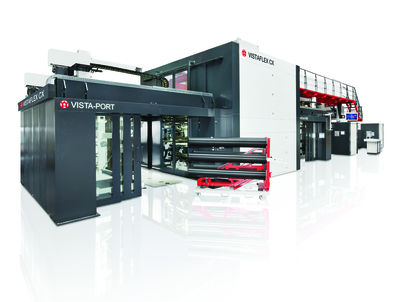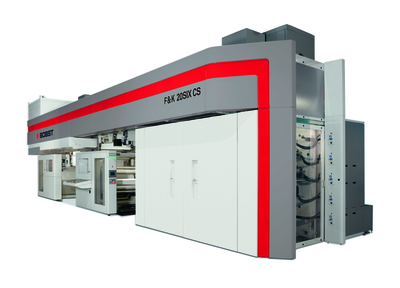The compact F&K 20SIX press can be specified for Low Energy Operation.
Flexo presses are becoming more efficient across the board from quicker job changeovers to reduced energy usage. Nessan Cleary brings an update.
Working with a flexo press is all about realising process efficiency, and to this end flexo press manufacturers have offered increasing levels of automation on their presses particularly in areas such as colour control and job changeovers. But there are a number of other trends, including the growing awareness of environmental issues, which have seen manufacturers looking at ways to conserve energy and reduce waste.
Bobst has developed the Low Energy Operation, or LEO, system for its latest series of presses, the F&K 20SIX which was first shown at drupa in 2012.
The optional LEO system conserves energy across all the major systems of the press. Thus there is extra insulation on the heating circuit, plus a solvent concentration control system to ensure that the thermal energy in the exhaust air is used more efficiently, as well as intermediate drying nozzles that can be individually opened and closed as and when required.
The 20SIX itself is a central impression (CI) press that builds on Bobst’s successful FP16 series but with redesigned precision bearings and locking mechanisms to eliminate any vibrations. This is complemented by servo drives for registration accuracy so that impression adjustment can be set to within 1 micron. Machines built to the LEO specification also gain energy recovery modules for the servo drives, as well as energy-saving modes that switch the machine to the most efficient state at the push of a button during downtimes and production times.
All the major functions are easily accessible for set up and maintenance. There is even a combined carrier module and ink chamber module designed to make replacement of ink chambers and doctor blades as smooth as possible. The press can run at 400-600 m/min with a web width of 1100-1700 mm.
Reducing changeover
Earlier this year Windmöller & Hölscher (W&H) announced a new Vistaflex CX press, the top model in its range of CI presses. It is an eight colour press, 2200 mm wide, running at up to 800 m/min. Said to be able to cope with very short job change times, for up to 20 job changeovers a day, it features an automated robot handling system, Vistaport, that can load the plate cylinders and anilox rollers into the colour decks. It can also prepare the plate sleeves and anilox rollers for the next job to speed up the changeovers.
The company has also developed a number of automated systems to cut down on energy usage, such as the TurboClean system for automatic wash up of the ink supply system reducing the amount of ink and solvent used, as well as the time taken down to just four minutes.
Tom Wiltshire, director of the UK agent Wantzen Limited, said there is a movement towards using fixed colour gamuts, typically with six process colours, to reduce problems of colour matching and particularly the time needed for each changeover. He explained that there is an alternative in computer-aided modelling, such as the W&H EasyCol module, which still uses spot colours but can adjust the printing inks to the exact given reference value in no more than two correction steps, which cuts down on both set-up time and the amount of ink wasted.

W&H has launched the Vistaflex CX, an eight colour press with a 2.2 metre print width
Electron beam
Uteco has also addressed environmental issues with its electron beam (EB) drying technology, with the latest iteration being the EB3 Advanced machine project. This is currently implemented on the Onyx 810 press, which has a printing width of 1600 mm plus a printing repeat maximum of 1100 mm and which runs at 450 m/min. It uses Uteco’s Thermilox technology, which allows the ink temperature to be controlled so that it can be optimised at the point of printing precisely for each job run.
Thermilox also allows the temperature to be set independently for each colour group. This has a number of benefits, including better dot reproduction and trapping as well as simpler washing. Better still, because there is no solvent in the EB inks, it is also suitable for food packaging printing.
The Onyx line all use a CI design combined with direct drive technology whereby the drum and the plate sleeve mandrels are flanged directly into their drive motors for improved dot quality. The range includes six, eight and ten colour presses with a choice of 1200 and 1600 mm print widths, all running at a maximum of 450 m/min.
Comexi’s efforts for sustainable printing are focused around its Offset CI8 press, which also uses electron beam curing. The company has also targeted the food packaging market, pointing out that these inks differ from UV-curable inks in that they do not contain photoinitiators thus reducing the risk of migration to the food.
The company also produces a version of the Flexo F2 press that works with water-based inks. It has a high flow drying system that dries white as a first colour background with dehumidified air. On top of this, Comexi has also increased the drying capacity between colours by 50% over that of its solvent presses. It is an eight colour press with a maximum printing width of 1470 mm and maximum print speed of 500 m/min.

The Uteco Onyx 810 features EB3 electron beam curing technology
Shorter runs
Another ongoing trend in the flexo market is towards shorter print runs.
At the end of last year, Soma Engineering launched its Optima press which has been designed to handle short runs cost effectively. Marketing manager Petr Blasko explained, ‘Our research has shown that the flexo printing market wants consistent quality of 70 lines per cm with as short a set-up time as possible.’ He said that the Optima could even be used to compete against narrow web presses, noting, ‘We can foresee the possibility of high speed printing label and packaging substrates on an 820 mm wide model by splitting into two 400 mm wide webs and adding various offline finishing options such as embossing, foiling and other decorative and converting applications.’
For the Optima, Soma placed the unwind and rewind systems outside the printing unit modules. This means that users can choose any unwind/rewind configuration and inline upstream or downstream printing and converting units such as placing the primer coating before print or a lacquer coating after print. This design also means that the unwind and rewind systems can be located in ‘face-to-face configuration’ where the parent roll and finished reels are handled in the same area.
The company produces two other flexo press lines, the Imperia and the Premia. All of the Soma presses use a central impression architecture. They are designed mainly for printing on paper, films, laminates and foils, and boast a high degree of automation. They use a gearless direct drive system for fast acceleration while the central drum has a thermal stabilisation system for better print quality. There is a self-adjusting chamber setting that compensates for wear on the doctor blade to maintain a constant angle on the anilox sleeve surface for longer blade life.
The Premia is designed for medium to long runs and is a 1270 mm wide with 915 mm print repeat and runs at up to 500 m/min. It is an eight colour press that uses solvent and water-based as well as UV-curable inks. The top of the range Imperia can run at up to 650 m/min with a print width of 1050 or 1270 mm. It has 10 print decks and can print to a wide range of substrates with solvent and water-based inks, but not UV-curable.
Splitting the web
Flexotecnica, now part of KBA, sells the Evo X range, an extension of its XG and XD ranges. The Evo X presses rely heavily on automation to reduce waste. Thus the Evo XD allows print impression positions to be controlled to within 30 metres for reduced waste on start up. It also has software to analyse the target colours in a printed product to make it easier to set the inks up correctly. It is a central impression press and can be configured with 8 or 10 print decks and has a printing width of 1000-1600 mm. The doctor blade assembly features a new generation of lightweight chambers that move on linear guides that are pneumatically adjustable from either side. There is a new ventilation system plus a closed loop drying tunnel that uses less energy and is easy to service as well as quicker for drying solvent and water-based inks.
KBA-Flexotecnica has also picked up on the trend toward using wide web presses to compete in the label market by splitting the web into two halves. It has developed two further variations, the XDs and XDn, designed specifically for short runs. Both have eight print decks and run up to 350 m/min, but the XDs prints up to 600 mm wide, while the XDn handles widths up to 1100 mm. They can use solvent and EB inks for packaging as well as water-based and UV inks for labels.
The company also sells the more heavy duty Evo XG press, which has up to 10 print decks and can run at up to 600 m/min. It has a print width of 1600 mm, though there is an option to extend this to 2000 mm.
In conclusion, brand owners continue to demand both better print quality as well as lower costs. This is behind all the recent developments, including the move to cut down on waste and energy consumption and including the trend towards competing in the label market.






